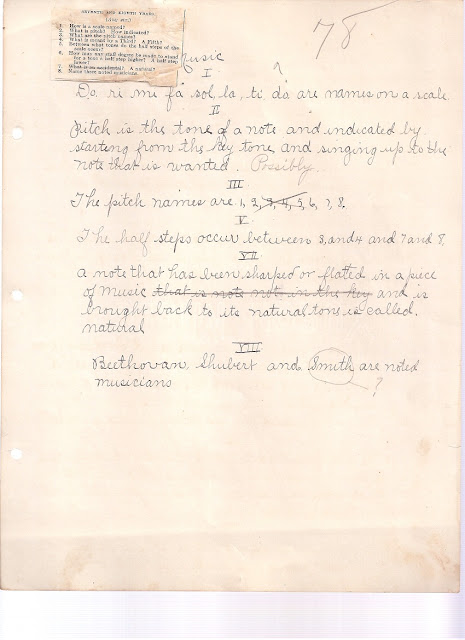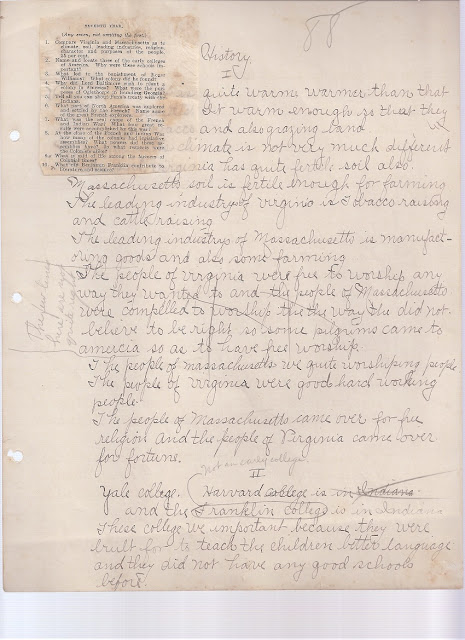Originally published on genealogyatheart.blogspot.com on 29 Oct 2015
I absolutely love the internet – it’s my favorite improvement in life. I could live without kitchen appliances, television, cell phone and backup camera on my car but I wouldn’t want to return to the days of no internet.
I first used the internet in 1993 at a reading festival at Eckerd College where a text only version was being demonstrated and I was eager to have it at home. My husband got us online in August 1995. It’s been 20 years and my, has it changed our lives for the better!
When you think of spooky, spine tingling stories you think of creepy old houses, forlorn looking graveyards and the dark of night. The internet is most likely last on your list of where ghostly happenings occur but it has happened to me on more than one occasion.
My most recent strange encounter began in January 2014. I had been thinking about a deceased great aunt that I had loaned a musical instrument to in the late 1970’s. I never got the instrument back and wondered what had happened to it. I assumed one of her children had it. Within a day of this thought I received an email from one of the aunt’s children who I had not seen since I was a child. The email was curt and demanded that I correct misinformation regarding his parents that I supposedly had placed on Find-A-Grave. I recognized his name and immediately wrote back calling him by my childhood nickname for him. Strange how I had just thought about his mom the day before! I informed him that I was not the memorial owner and had tried to correct the wrong information in 2 prior emails but the owner had never responded. I did post a photo of his parents on the site and that is why he thought I was responsible for the wrong information. I suggested he contact Find-A-Grave administration and forwarded my previous emails to the memorial owner to him to support his concern.
We corresponded via email for two months. He had hired a genealogist from across the pond and had taken a trip himself to research. He was adamant that some of my information was in error. Thank goodness I cite my sources as I was able to explain where I obtained it, which was mostly word of mouth from my grandmother. If you’re a faithful reader, you know my maternal grandmother was a strong family matriarch and did tend to dramatize the telling of stories so his concern of accuracy was understandable. However, I would think she would know how many siblings she had and what their names were; he believed the family had 2 daughters and 1 son when my records show 3 daughters and 3 sons. I suggested he contact his overseas genealogist who verified that my information was correct. The genealogist had missed these children because she had begun searching Baptism records in 1900. The 3 oldest children were born in the late 1890’s and died prior to emigrating to the United States. It was an understandable error as he had thought my grandmother was the oldest and she was born in 1900. He hadn’t known she was the oldest SURVIVING child.
I sent via snail mail a dvd of all the family photos and scanned documents to him. He had promised to send me copies of his photos but never followed through. I volunteered to take a photo of his birth dad’s gravestone which is not far from my home but he never replied.
Two months after we began exchanging emails he informed me that his sister had passed away and directed me to an online memorial site run by the funeral home. I posted my memories of her on the site and sent my condolences to him which he didn’t acknowledge. This was our last email exchange.
What was so odd was that his sister had died within 10 days of our initial contact. Why had he waited 2 months to tell me of her death?
In May, I received an email from a “friend” of my deceased second cousin. She mentioned that she had seen my posting on the funeral home site. The friend had tried to contact closer family but no one responded to her. What should she do with my second cousin’s ashes? Huh?! I had to read the email twice to absorb the question.
We began corresponding and I learned, sadly, that my deceased cousin had died alienated from family. She had had a falling out with her sibling which explained why her brother had not told me about his sister’s death immediately. He hadn’t known. Two months after the death the friend went online to try to find addresses for siblings and found the Find-a-Grave memorial now owned by the brother. That was how he discovered his sister had passed. Instead of responding to the friend, he forwarded the information to me. No wonder he didn’t reply to my condolences.
I was sick to my stomach. Knowing both my grandmother and her sister, my husband said it was a good thing this happened after they were long dead because they would have been livid. I agreed.
How could I try to make the situation right? Obviously, it was too late for sibling reconciliation.
The friend told me that my second cousin’s wish was to be interred with one of her parents. The friend and a former co-worker had planned to scatter the ashes on the graves but they didn’t know where the parents were buried. Going through my cousin’s belongings after her death didn’t provide them the answer so they waited til spring and turned to Find-a-Grave for help. When they discovered the cemeteries were out of state they didn’t know what to do so they contacted the brother for help. With no reply from him they were at a loss until they saw my tribute.
I told them I would scatter the ashes and offered to pay for their time in finalizing my cousin’s estate. There was no reply to my offer.
In early June, I arrived home from the dentist to discover 3 boxes on my front porch. Dragging them inside, hubby and I grabbed a knife to cut the tape. There was a return address so I expected what I would find. The first box contained a cut glass vase, a coconut rice bowl, olive wood candlesticks, and a Hummel figurine. The second box contained pictures, certificates, a Bible and medical records belonging to my cousin. The third box was her cremains.
An entire lifetime reduced to 3 boxes left on a doorstep.
My husband responded like he always does when odd things happen to me, he shook his head and said, “The weirdest things happen to you.” My co-workers thought this was hilarious. “Only you have your relatives UPS’d.” I found it very sad. This cousin was a role model for me as a child and I was deeply embarrassed by my family’s hard headedness.
I emailed the friend that I had received the packages and told her I would be sending her a check in the mail. She didn’t respond. She never cashed the check or acknowledged receiving it.
Unfortunately, the death certificate was not included in the boxes. I contacted the cemeteries where her birth parents were interred and was told that scattering of ashes was forbidden and interring cremains could only happen with a death certificate. I couldn’t obtain a death certificate because my cousin died in a state that requires either a will, proof of life insurance bequeathment, or shared property. Now I was dealing with 3 states and no one would make an exception. I wrote again to the friend requesting a copy of the death certificate. The email bounced back as undeliverable. I sent a letter via snail mail. No reply. I went online trying to find a phone number but the person didn’t exist. Looked in the white pages, used Spokeo, called the funeral home – nope, nothing. The friend had vanished.
In mid July I received a call from one of the cemeteries who told me that an exception was being made. I followed the directions I was given and on my grandmother’s 114th birthday the cremains were finally at rest. I was asked to not divulge that an exception was made and I’ll honor that request. Even my kids don’t know how the story ended; they just knew that their 3rd cousins ashes were no longer in the entryway.
I can’t say if the change of heart was due to Divine Intervention but I’m fairly certain it was somehow my grandmother’s intervention.
And about that musical instrument. Well, it wasn’t in the boxes so it’s still out there somewhere. I’m fairly certain I’ll be getting a replacement soon. How do I know? As I wrote this, the mail was delivered and it contained my new passport. I had forgotten hubby and I sent the renewal in early last month. How odd that it arrived while I was writing this…

















